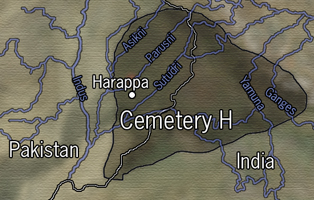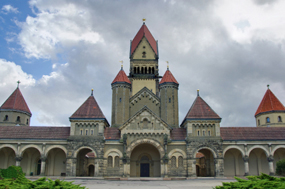The history of mankind is a long and fascinating story, and the majority of it is apparently lost forever. For those inquisitive minds searching the distant past in the hopes of possibly gleaning some foresight into our future, we fortunately do have written, historical records documenting the affairs of human beings over the past few thousand years. For the older parts of the story that have occurred before our ability to write down important events, scientists and other researchers often rely on modern technology to aid in our understanding of the ancient past.
Through many archaeological discoveries, we have learned a great deal about our ancestors of prehistoric times. While not everyone is completely satisfied by the answers provided by science, many researchers feel confident that recent developments in scientific technology, such as radiocarbon dating, can reveal a fairly accurate timeline of our prehistory that would have otherwise been lost.
 |
|
Fossilized human remains discovered in Australia indicate that some of the earliest humans performed complex funeral customs.
|
|
By carbon dating fossilized skeletal remains, scientists believe they’ve found evidence to suggest that modern humans (or anatomically-modern humans) have walked the earth for the past 200,000 years. Since these ancient people are considered to be anatomically-modern, it would seem reasonable to assume that the minds of these prehistoric people worked similarly to ours and they therefore possessed many of the same fears, emotions, and other thought patterns as we do today in the 21st century. Likewise, then, it would seem reasonable to assume that these ancient people also felt many of the same complex set of emotions regarding death that we still feel to this very day. However, lacking any scientific evidence, any assumption made about these people would be nothing more than pure speculation.
Everything we assumed about these ancient people changed with some major archaeological discoveries during the latter part of the 20th century. Most notably, the world’s earliest known example of cremation as a mode of final disposition was discovered at a dig site in Australia by scientists examining fossilized bone fragments. The remains were found to be those of a woman, and after carbon dating, the researchers discovered that she had lived approximately 26,000 years ago. In addition to being the first known example of cremation, the discovery was also remarkable because burn mark patterns found on the bones seemed to indicate that complex funeral rituals were performed by the woman’s survivors at the time of her death.
The Neolithic Age
 |
|
An ancient Sumerian wall carving.
|
|
Throughout human history, the funeral customs performed by a particular culture were as unique and diverse as the individual cultures themselves. The method of final disposition that one group preferred over another, such as earth burial, cremation, or entombment, was selected by particular cultures based on tradition, superstitions, and religious beliefs held at the time, among other reasons. When one culture was conquered by another, it was not unusual for the two societies to begin to merge over a period of several generations, and with time also brought an eventual transformation of dominant social norms and religious beliefs within the group.
The religion of the Ancient Egyptians was based primarily around the concept of transmigration of the soul, or reincarnation. The modern practice of embalming finds its roots in the ancient Egyptian practice of mummification, and due to this complex belief structure regarding the afterlife, cremation was prohibited. According to some historical accounts, the Babylonians also embalmed their dead. Early Persians practiced cremation, but cremation was eventually prohibited during the Zoroastrian period. The Phoenicians practiced both cremation and burial. From the Cycladic period in 3000 B.C. until the Sub-Mycenaean era in 1200-1100 B.C., the Greeks practiced earth burial.
The Bronze Age
 |
|
Cemetery H, the shaded area on the map, is located on the border of India and Pakistan.
|
|
During the Bronze Age, 2500 to 1000 B.C., the practice of cremation moved from the Fertile Crescent into Central and Western Europe. On the Indian Subcontinent, a cemetery was discovered in the Indus River Valley, located near the border of India and Pakistan, called Cemetery H. It was named after 'area H,' a section of the archaeological excavation site near the town of Harappa. The discovery of this cemetery was so significant that the people from this region and time period (around 1900 to 1300 B.C.) are now historically known as 'Cemetery H culture.'
Painted pottery urns containing the cremated remains of the dead were unearthed at the cemetery, and this discovery is one of the first known examples of cremation on the Indian Subcontinent. Some scholars believe Cemetery H culture is one of the cultures that gave birth to Vedic civilization. The Vedic civilization’s belief system is the precursor to modern Hinduism and cremation is nearly the universal form of final disposition in the Hindu religion.
When Gautama Buddha died, sometime around 400 B.C., his body was cremated and his ashes and certain relics were placed in several monuments. The cremation of 'the enlightened one' followed a tradition that arose from ancient Cemetery H culture. Buddhism and other Eastern religions eventually spread throughout Asia, and cremation became the traditional form of final disposition throughout much of present-day China, Japan, Korea, Thailand, Vietnam, Singapore, Indonesia, Malaysia, Hong Kong, and Sri Lanka. Cremation is still the dominant form of final disposition in most of Asia to this very day.
In the Mycenaean Age, circa 1000 B.C., cremation was highly-recognized form of disposition among the Greeks. Homer describes cremation in both the Iliad and the Odyssey. Cremation was also prevalent in times of war for the ancient Greeks.
 |
|
The remains of a Roman columbarium, beside the Via Appia to the south of Rome.
|
|
Following the traditions and other influences of the ancient Greeks, the ancient Romans, from 27 B.C. to 395 A.D., also embraced cremation. Cremation was often associated with military honors and royalty. It eventually became such a widespread practice that official decrees were established to prevent cremations from taking place within the city. The cremated remains were sometimes stored in decorative urns, and placed in large, underground columbaria.
A columbarium is a large vault where the cremated remains were placed within small wall niches. The term columbarium comes from the Latin columba, meaning 'dove' and originally referred to compartmentalized housing for doves and pigeons. The individual niches were marked in a variety of ways to identify each compartment.
The Christian Era
Though the practice was prevalent among the Romans, cremation was rare with the early Christians who considered it pagan, and in Jewish culture, traditional sepulcher entombment or earth burial was required by Jewish law. However, by 400 A.D., as a result of Constantine’s Christianization of the Roman Empire, earth burial had completely replaced cremation. Cremation was thought to be incompatible with Christianity’s doctrine of the resurrection of the physical body. Except for instances of plague or war, earth burial became the accepted and dominant mode of disposition throughout Europe for over 1,500 years.
In 1963, Pope Paul VI lifted the ban on cremation, and in 1966, he allowed Catholic priests to officiate at Masses of Christian Burial involving cremation. The Roman Catholic Church still officially prefers the traditional internment of the deceased. Despite this preference, cremation is now permitted by the Roman Catholic Church as long as it is not done to express a refusal of Christian belief in the physical resurrection of the body. Cremation is still not permitted under any circumstances in Eastern Orthodox Christianity.
Modern Cremation
 |
|
A crematorium in Leipzig, Germany.
|
|
Like other developments in modern funeral practices, like embalming, cremation as we know it today also began in the mid-to-late 1800s after the development and perfection of reliable machinery and equipment used to perform the cremation. After these developments, cremation began to be promoted by various cremation societies throughout England and Germany as an alternative to traditional earth burial.
The instances of cremation were also beginning to rise in the United States. Early cremation societies forming in America were also beginning to promote cremation, as well some medical professionals concerned about public health. Additionally, some members of the Protestant clergy embraced cremation as a way to reform funeral practices. Because of cost concerns, limited space in cemeteries, and changing social attitudes, cremation is now quickly becoming the most common form of disposition in the world.
Cremation Tomorrow
 |
|
Alkaline hydrolysis is a new technology that may one day replace combustion-based cremation.
|
|
Interestingly, a new technology has now been perfected that may eventually replace traditional combustion- or incineration-based cremation. This modern process is called alkaline hydrolysis and works by accelerating the natural decomposition process using sodium hydroxide (lye), sympathetically returning the body to ash within about four hours.
Alkaline hydrolysis creates no air pollution and emits no greenhouse gases. It emits twenty times less carbon dioxide than with combustion-cremation. It uses only 10 percent as much energy per body as combustion-cremation, it completely neutralizes embalming fluid, and it produces natural, contaminant-free cremains.
Unfortunately, alkaline hydrolysis is still relatively new and is fairly cost prohibitive. However, in the next decade, alkaline hydrolysis is certain to become a popular choice simply because it is much more practical and environmentally-friendly than combustion-cremation.
|